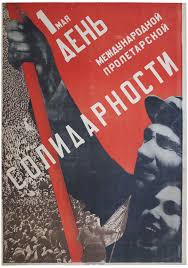
Gustav Klutsis: Master of Soviet Photomontage
Share
Gustav Klutsis: A Master of Soviet Photomontage - Poster Artist
Gustav Klutsis, a Latvian-born Soviet artist, was a pioneering figure in the development of photomontage, a technique that would become synonymous with Soviet propaganda. His bold, dynamic compositions, often featuring fragmented images and striking typography, captured the revolutionary spirit of the early Soviet era.
Early Life and Career
Born in Latvia in 1895, Klutsis moved to Moscow after the Russian Revolution of 1917. He enrolled at the VKhUTEMAS, a prestigious art and technical school, where he studied under the influence of Constructivist artists like Kazimir Malevich and Alexander Rodchenko.
Constructivism and Photomontage
Klutsis embraced the principles of Constructivism, a movement that sought to use art as a tool for social and political change. He was particularly drawn to the idea of art as a means of communication and propaganda. Photomontage, a technique that involved combining different photographs to create a new image, became a powerful tool for Klutsis to convey his revolutionary message.
The New Soviet Man
Klutsis's photomontages were characterized by their bold, dynamic compositions and their use of dramatic lighting and perspective. He often juxtaposed images of industrial machinery, workers, and political leaders, creating powerful visual metaphors that celebrated the achievements of the Soviet Union.
A Collaborator and Innovator
Klutsis often collaborated with his wife, Valentina Kulagina, another prominent Constructivist artist. Together, they created a body of work that pushed the boundaries of photomontage and graphic design. Their work was characterized by its innovative use of color, typography, and spatial composition.
Klutsis's influence extended beyond the Soviet Union. His work was exhibited internationally, and he was recognized as one of the leading figures of the avant-garde movement. His innovative techniques and bold aesthetic continue to inspire artists and designers today.
A Tragic End
Despite his significant contributions to the world of art and design, Klutsis's life was cut short. He was arrested in 1938 during the Stalinist purges and executed, along with many other artists and intellectuals. His death marked the end of a brilliant career and a significant loss for the Soviet avant-garde.
Legacy
Despite his untimely death, Klutsis's legacy lives on. His innovative use of photomontage and his commitment to social and political causes have had a lasting impact on the history of art and design. His work continues to inspire and challenge, reminding us of the power of art to shape our understanding of the world.
References:
Gustav Klutsis - Wikipedia: https://en.wikipedia.org/wiki/Gustav_Klutsis
Gustav Klutsis - MoMA: https://www.moma.org/artists/12501
Gustav Klutsis - The Art Institute of Chicago: https://archive.artic.edu/avant-garde/klutsis/
Gustav Klutsis - Tate: [invalid URL removed]
Citations:
Wikipedia contributors. (2023, September 28). Gustav Klutsis. Wikipedia, The Free Encyclopedia. Retrieved November 1, 2023, from https://en.wikipedia.org/wiki/Gustav_Klutsis
MoMA. (n.d.). Gustav Klutsis. Retrieved November 1, 2023, from https://www.moma.org/artists/12501
The Art Institute of Chicago. (n.d.). Gustav Klutsis. Retrieved November 1, 2023, from https://archive.artic.edu/avant-garde/klutsis/




